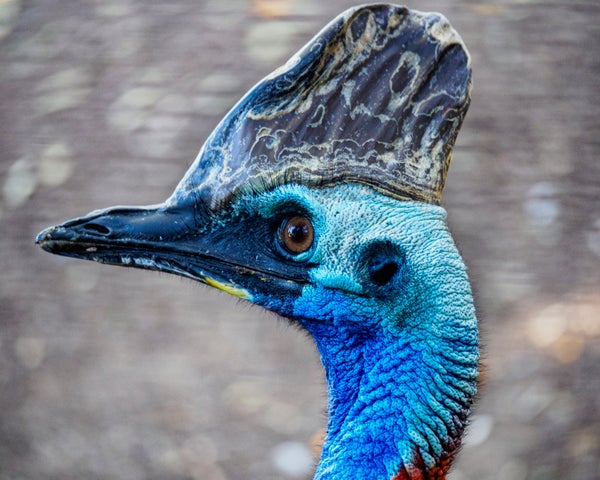This article was published in Scientific American’s former blog network and reflects the views of the author, not necessarily those of Scientific American
Today, it’s time to revisit the Tet Zoo archives, and post this (now very old) section of text on cassowaries. It first appeared here (at Tet Zoo ver 2) back in May 2007. I haven’t finished on the Mesozoic maniraptorans, by the way (for parts published so far see part 1, part 2, part 3).
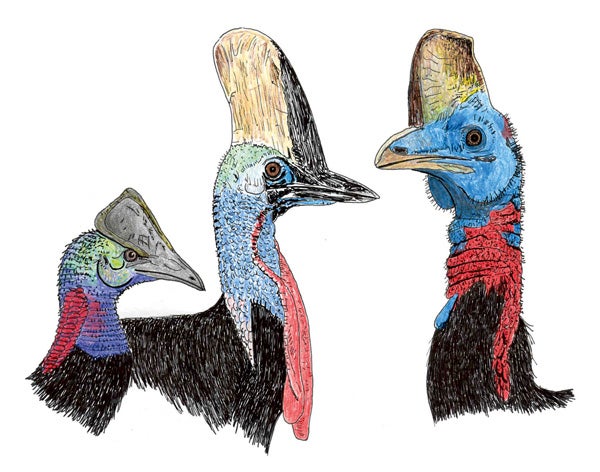
A cassowary montage. L to r: Dwarf or Bennett's cassowary (Casuarius bennetti), Double-wattled or Southern cassoway (C. casuarius), Single-wattled cassowary (C. unappendiculatus). Credit: Darren Naish
It’s well known that cassowaries can be dangerous, and indeed together with ostriches [UPDATE: and chickens] they are the only birds known to have definitely killed humans*. On mainland Australia, the most recent recorded fatality occurred in April 1926 when 16-year-old Phillip McClean received an injury to the throat after running from a cassowary and falling to the ground. I've also encountered references to the death of a zookeeper named Luke James who was apparently killed by a captive cassowary, but have only read about this online and am not sure as to its reliability (readers: please let me know if have access to any further information on this case).
On supporting science journalism
If you're enjoying this article, consider supporting our award-winning journalism by subscribing. By purchasing a subscription you are helping to ensure the future of impactful stories about the discoveries and ideas shaping our world today.
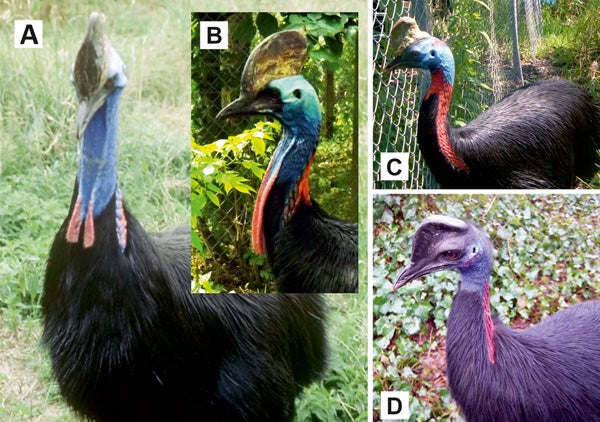
Another cassowary montage, this time from Naish & Perron (2014). (A) Double-wattled or Southern cassowary (Casuarius casuarius). (B) Double-wattled cassowary in profile. (c) Single-wattled cassowary (C. unappendiculatus). (d) Dwarf or Bennett’s cassowary (C. bennetti). Credit: D. Naish and R. Perron
* Bits of children have been discovered beneath the nests of African crowned eagles Stephanoaetus coronatus, but we’re not totally sure that the eagles did the killing. Furthermore, there are various anecdotal accounts of Golden eagles Aquila chrysaetos killing humans... but if you’ve been visiting the blog for a while you’ll know this.
Attacking cassowaries charge and kick, sometimes jumping on top of the victim. Unlike emus, which reputedly can only kick backwards (no, I don’t believe this either), cassowaries can kick in a forward and downward direction. They may also peck, barge or head-butt. The commonest injuries they cause in humans are puncture wounds, lacerations and bone fractures. Serious injuries resulting from cassowary attacks are most likely to occur if the person is crouching or is lying or has fallen on the ground. When confronted with a charging cassowary it’s clearly unwise to crouch or turn one’s back on the bird. Claims that jogging incites cassowaries to attack (supposedly because the sound of running feet imitates a foot-stamping rival cassowary) do not withstand scrutiny as walking people have been attacked more frequently than joggers.
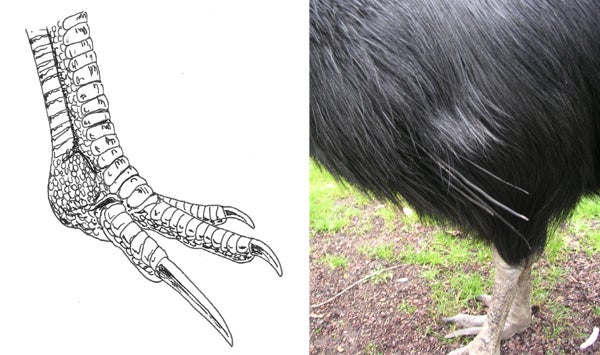
A cassowary's primary weapon is its dagger-like digit II claw, shown at left. Digit I is absent in these birds. This is a left foot, seen from the inside. The reduced wings possess spine-like quills (shown at right), but these aren't used in offensive fashion. Credit: Darren Naish (drawing); Markus Buehler (photo) used with permission
However, cassowaries do not attack indiscriminately and a 1999 study by Christopher Kofron (1999) of 221 recorded attacks by Casuarius casuarius johnsonii showed that attacks are mostly due to association of humans with food. Several attacks (7) appeared to be a territorial reaction to the presence of humans in an area where the cassowary was feeding while some (32) were clearly defensive – the cassowary was either protecting itself or its chicks or eggs. McClean’s death in 1926 was not the result of an unprovoked attack: he had struck the bird with the intention of killing it and had then fled; he also had a dog with him (Kofron 1999, 2003). By far the greatest number of attacks (109) involved soliciting of food by the cassowary. In areas where humans have taken to feeding cassowaries, some cassowaries act boldly and aggressively in expectation of being fed and will run up to or chase people, sometimes kicking if no food is offered. Kofron (1999) reported that such behaviour was not recorded in his study area prior to 1985. Human feeding would thus appear to have modified cassowary behaviour and in fact cassowaries are naturally wary and highly unlikely to attack without provocation.
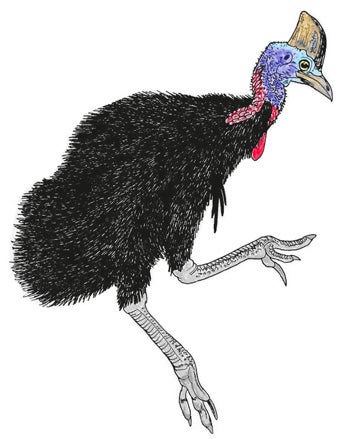
Cassowaries can easily leap high enough to kick an adult person at chest height. Some of you will recognise the pose depicted in this drawing - it's not original but copied from an illustration in a book. Credit: Darren Naish (photo)
Cassowaries will also kick or peck at doors and windows, sometimes breaking panes of glass or screen panels. In these cases they are presumably attacking a reflection which they perceive as another cassowary. They will also kick or chase cars, again because they appear to associate the human occupants with food. Cassowaries dislike dogs and will attack them without provocation, presumably because feral dogs and dingos often prey on cassowaries. Between June 1996 and February 1997, six cassowaries were killed by dogs in the Cairns area and, of 35 cassowary attacks recorded by Kofron (1999) on dogs, 29 were in self-defence. Most incidents involving dogs concern a dog approaching or pursuing a cassowary; the cassowary, when possible, then faces at least one of the dogs, kicks it, and the dog is either lacerated or bodily punctured by the cassowary's foot claws. The more severe of these injuries have resulted in swift death (Kofron 2003).
Cassowaries also dislike cats. Attacks on horses and cows have also been recorded and C. casuarius is anecdotally credited with having killed small horses, though confirmed attacks have only involved lacerations (Kofron 2003). These attacks were presumably territorial in motive.
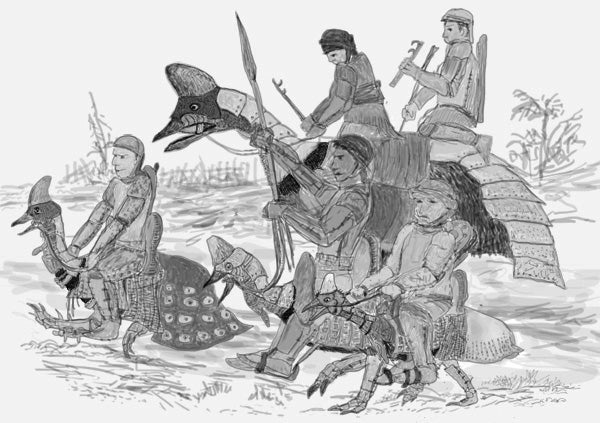
No, people never did ride armoured cassowaries into battle like this. But if they did, I bet it would be awesome. Credit: Darren Naish
It is not advised that captive cassowaries be kept with other species as they may attack and kill them. At Currumbin Sanctuary, Queensland, a cassowary killed an ibis and attacked some eastern wallaroos that entered its enclosure. However, cassowaries have also been successfully housed with other animals without incident.
I’ll finish with one last observation. It’s obviously true that cassowaries are dangerous and that they can, and will, hurt people on occasion. But it’s all too easy to exaggerate how dangerous they are, and we shouldn’t forget that an enormous number of interactions occur that don’t end in aggression or injury. And for all the hype surrounding cassowary aggression, let us also not forget that it is frequently we – speeding along in our vehicles –who are a danger to them.
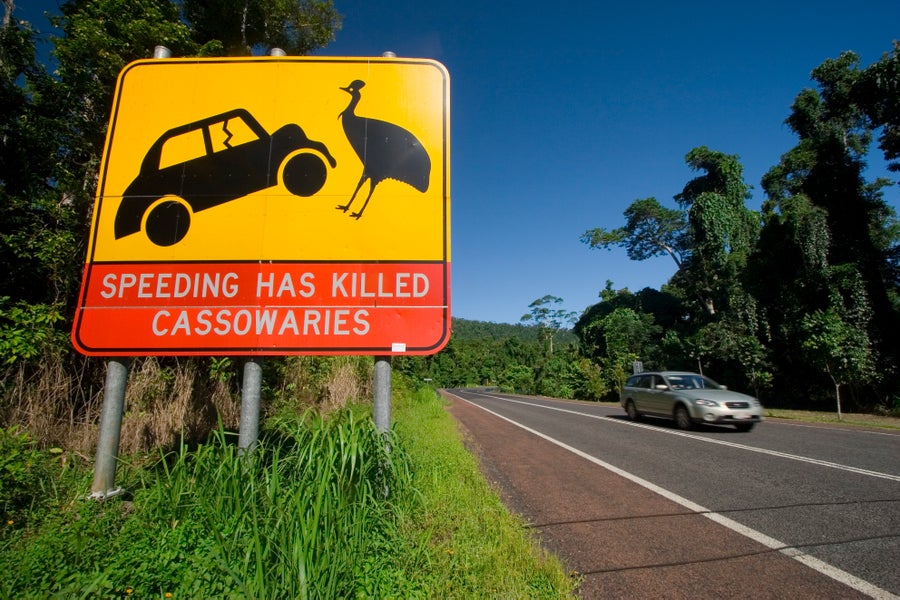
Road sign in Cairns, Australia. Credit: Paul Dymond Getty Images
Cassowaries have been covered a few times before on Tet Zoo. See...
Walter Rothschild and the rise and fall of Sclater’s cassowary
Did dinosaurs and pterosaurs practise mutual sexual selection?
Getting a major chapter on birds – ALL birds – into a major book on dinosaurs
Controversies from the world of ratite and tinamou evolution (part I)
Refs - -
Kofron, C. P. 1999. Attacks to humans and domestic animals by the southern cassowary (Casuarius casuarius johnsonii) in Queensland, Australia. Journal of Zoology 249, 375-381.
Kofron, C. P. 2003. Case histories of attacks by the Southern cassowary in Queensland. Memoirs of the Queensland Museum 49, 339-342.
